Evaluating Alternative Sands for Geotechnical Engineering Projects
VerifiedAdded on 2023/01/19
|36
|9462
|99
Report
AI Summary
This report delves into the utilization of alternative sands, specifically foundry sand and manufactured sand, within the realm of geotechnical engineering. It begins by defining and illustrating these materials, including their production processes and physical characteristics. The report explores the applications of these sands, particularly in pavement construction, soil stabilization, and ground improvement techniques. It also investigates the potential of microbial-induced calcite precipitation (MICP) for ground improvement and its applicability in Australia. Furthermore, the report addresses the environmental effects associated with these techniques and materials. It provides examples of their geotechnical applications and discusses the benefits and limitations of using alternative sands. The analysis also examines the general requirements of manufactured sand for improving soil subgrades, offering a comprehensive overview of alternative sands in geotechnical engineering.
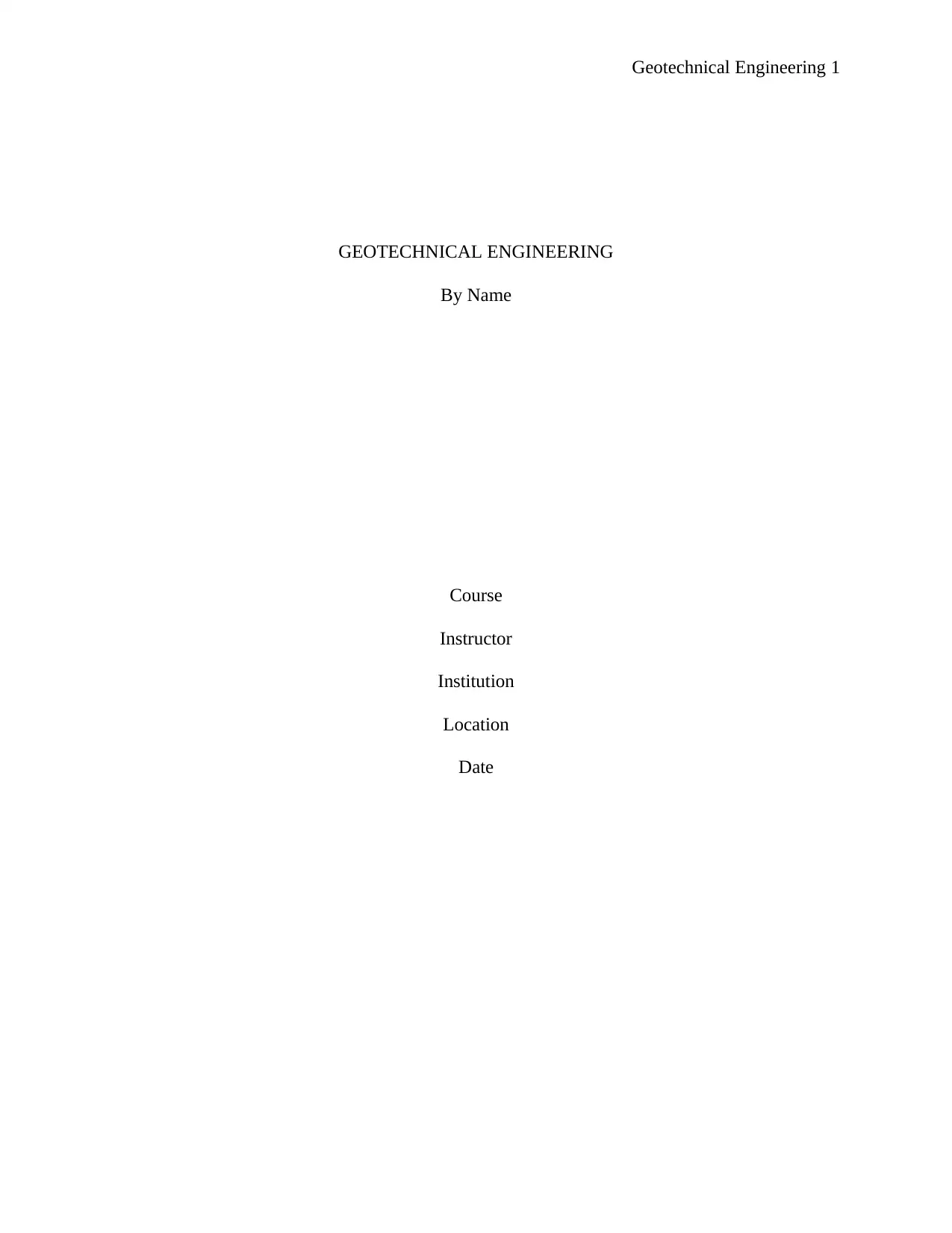
Geotechnical Engineering 1
GEOTECHNICAL ENGINEERING
By Name
Course
Instructor
Institution
Location
Date
GEOTECHNICAL ENGINEERING
By Name
Course
Instructor
Institution
Location
Date
Paraphrase This Document
Need a fresh take? Get an instant paraphrase of this document with our AI Paraphraser
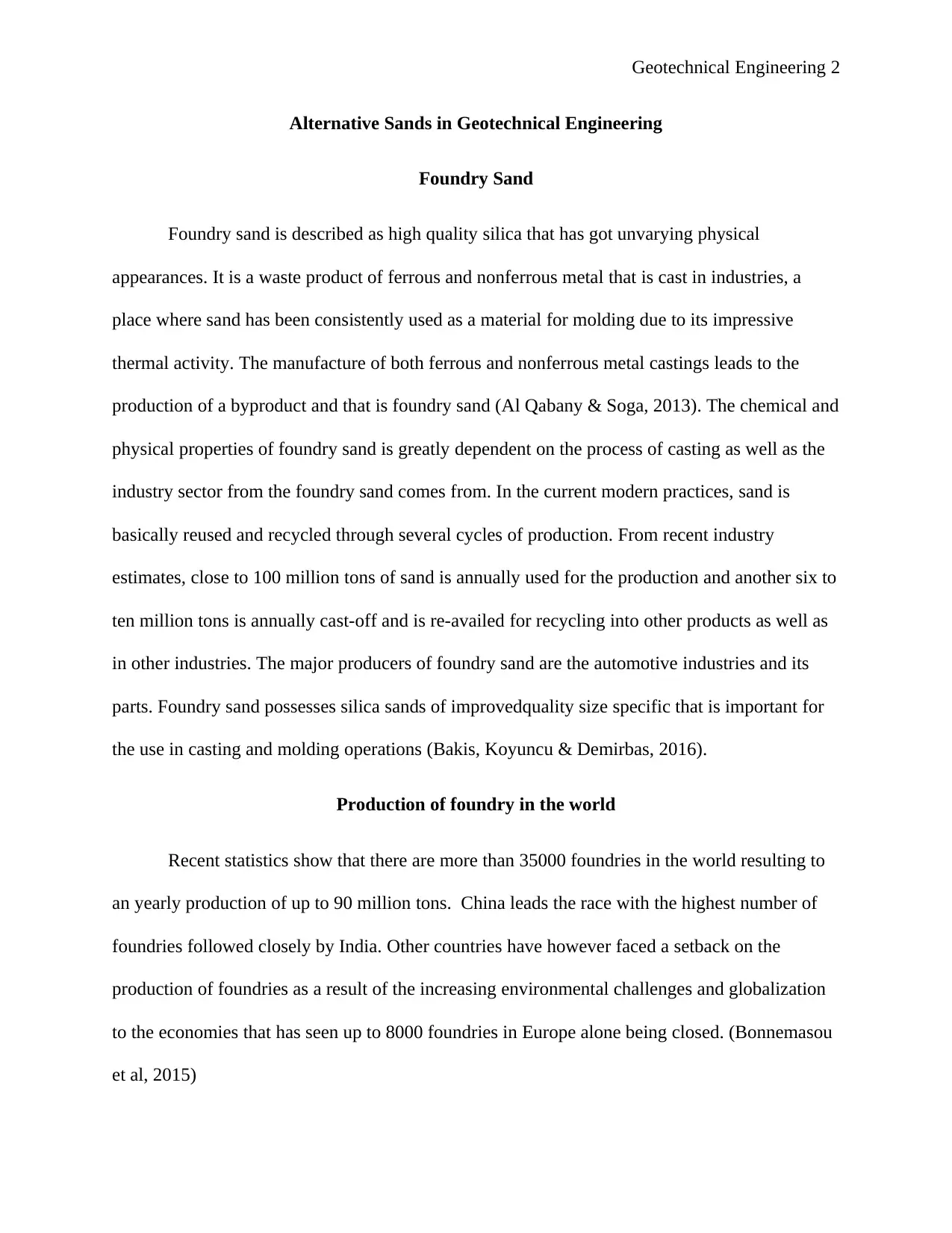
Geotechnical Engineering 2
Alternative Sands in Geotechnical Engineering
Foundry Sand
Foundry sand is described as high quality silica that has got unvarying physical
appearances. It is a waste product of ferrous and nonferrous metal that is cast in industries, a
place where sand has been consistently used as a material for molding due to its impressive
thermal activity. The manufacture of both ferrous and nonferrous metal castings leads to the
production of a byproduct and that is foundry sand (Al Qabany & Soga, 2013). The chemical and
physical properties of foundry sand is greatly dependent on the process of casting as well as the
industry sector from the foundry sand comes from. In the current modern practices, sand is
basically reused and recycled through several cycles of production. From recent industry
estimates, close to 100 million tons of sand is annually used for the production and another six to
ten million tons is annually cast-off and is re-availed for recycling into other products as well as
in other industries. The major producers of foundry sand are the automotive industries and its
parts. Foundry sand possesses silica sands of improvedquality size specific that is important for
the use in casting and molding operations (Bakis, Koyuncu & Demirbas, 2016).
Production of foundry in the world
Recent statistics show that there are more than 35000 foundries in the world resulting to
an yearly production of up to 90 million tons. China leads the race with the highest number of
foundries followed closely by India. Other countries have however faced a setback on the
production of foundries as a result of the increasing environmental challenges and globalization
to the economies that has seen up to 8000 foundries in Europe alone being closed. (Bonnemasou
et al, 2015)
Alternative Sands in Geotechnical Engineering
Foundry Sand
Foundry sand is described as high quality silica that has got unvarying physical
appearances. It is a waste product of ferrous and nonferrous metal that is cast in industries, a
place where sand has been consistently used as a material for molding due to its impressive
thermal activity. The manufacture of both ferrous and nonferrous metal castings leads to the
production of a byproduct and that is foundry sand (Al Qabany & Soga, 2013). The chemical and
physical properties of foundry sand is greatly dependent on the process of casting as well as the
industry sector from the foundry sand comes from. In the current modern practices, sand is
basically reused and recycled through several cycles of production. From recent industry
estimates, close to 100 million tons of sand is annually used for the production and another six to
ten million tons is annually cast-off and is re-availed for recycling into other products as well as
in other industries. The major producers of foundry sand are the automotive industries and its
parts. Foundry sand possesses silica sands of improvedquality size specific that is important for
the use in casting and molding operations (Bakis, Koyuncu & Demirbas, 2016).
Production of foundry in the world
Recent statistics show that there are more than 35000 foundries in the world resulting to
an yearly production of up to 90 million tons. China leads the race with the highest number of
foundries followed closely by India. Other countries have however faced a setback on the
production of foundries as a result of the increasing environmental challenges and globalization
to the economies that has seen up to 8000 foundries in Europe alone being closed. (Bonnemasou
et al, 2015)
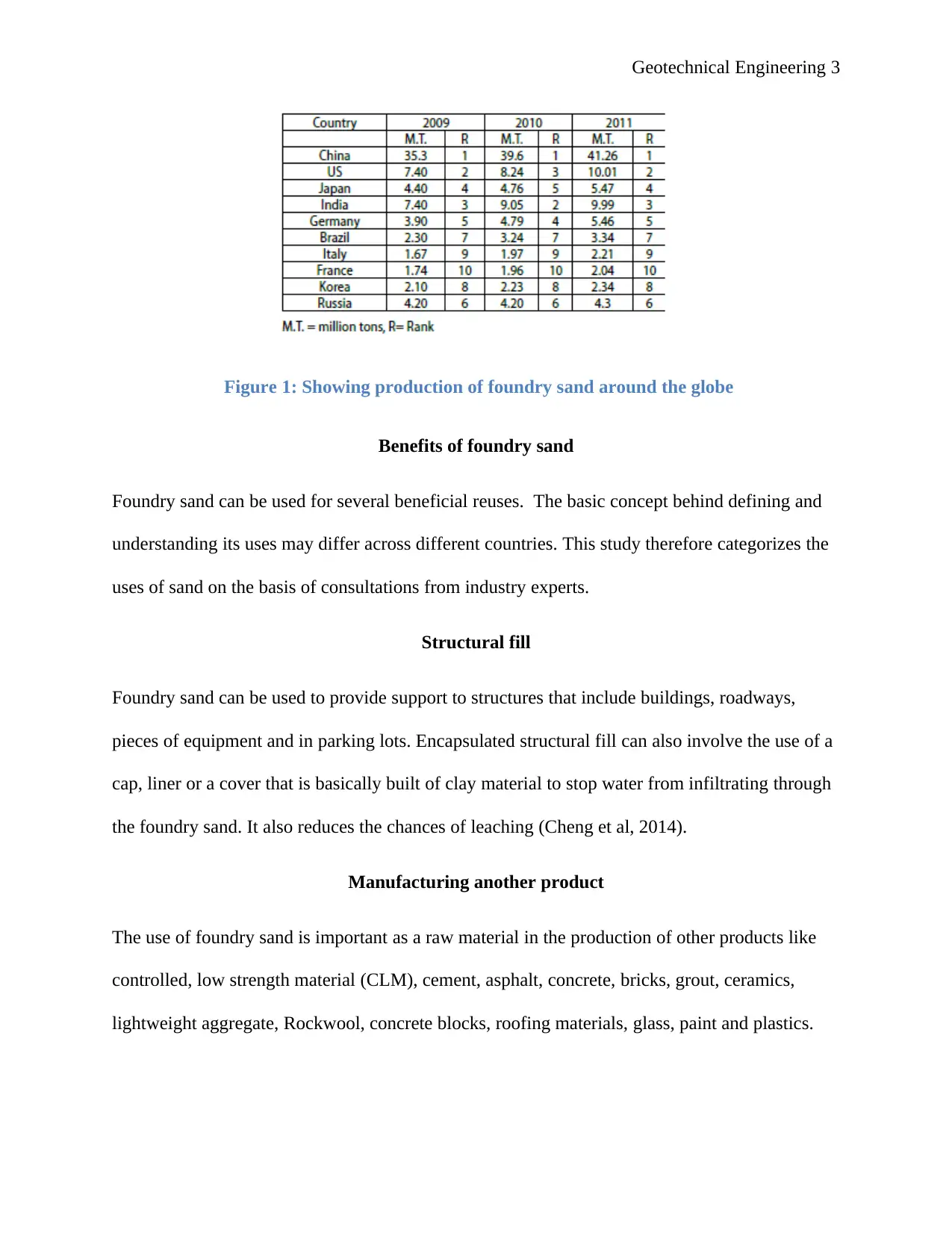
Geotechnical Engineering 3
Figure 1: Showing production of foundry sand around the globe
Benefits of foundry sand
Foundry sand can be used for several beneficial reuses. The basic concept behind defining and
understanding its uses may differ across different countries. This study therefore categorizes the
uses of sand on the basis of consultations from industry experts.
Structural fill
Foundry sand can be used to provide support to structures that include buildings, roadways,
pieces of equipment and in parking lots. Encapsulated structural fill can also involve the use of a
cap, liner or a cover that is basically built of clay material to stop water from infiltrating through
the foundry sand. It also reduces the chances of leaching (Cheng et al, 2014).
Manufacturing another product
The use of foundry sand is important as a raw material in the production of other products like
controlled, low strength material (CLM), cement, asphalt, concrete, bricks, grout, ceramics,
lightweight aggregate, Rockwool, concrete blocks, roofing materials, glass, paint and plastics.
Figure 1: Showing production of foundry sand around the globe
Benefits of foundry sand
Foundry sand can be used for several beneficial reuses. The basic concept behind defining and
understanding its uses may differ across different countries. This study therefore categorizes the
uses of sand on the basis of consultations from industry experts.
Structural fill
Foundry sand can be used to provide support to structures that include buildings, roadways,
pieces of equipment and in parking lots. Encapsulated structural fill can also involve the use of a
cap, liner or a cover that is basically built of clay material to stop water from infiltrating through
the foundry sand. It also reduces the chances of leaching (Cheng et al, 2014).
Manufacturing another product
The use of foundry sand is important as a raw material in the production of other products like
controlled, low strength material (CLM), cement, asphalt, concrete, bricks, grout, ceramics,
lightweight aggregate, Rockwool, concrete blocks, roofing materials, glass, paint and plastics.
⊘ This is a preview!⊘
Do you want full access?
Subscribe today to unlock all pages.

Trusted by 1+ million students worldwide
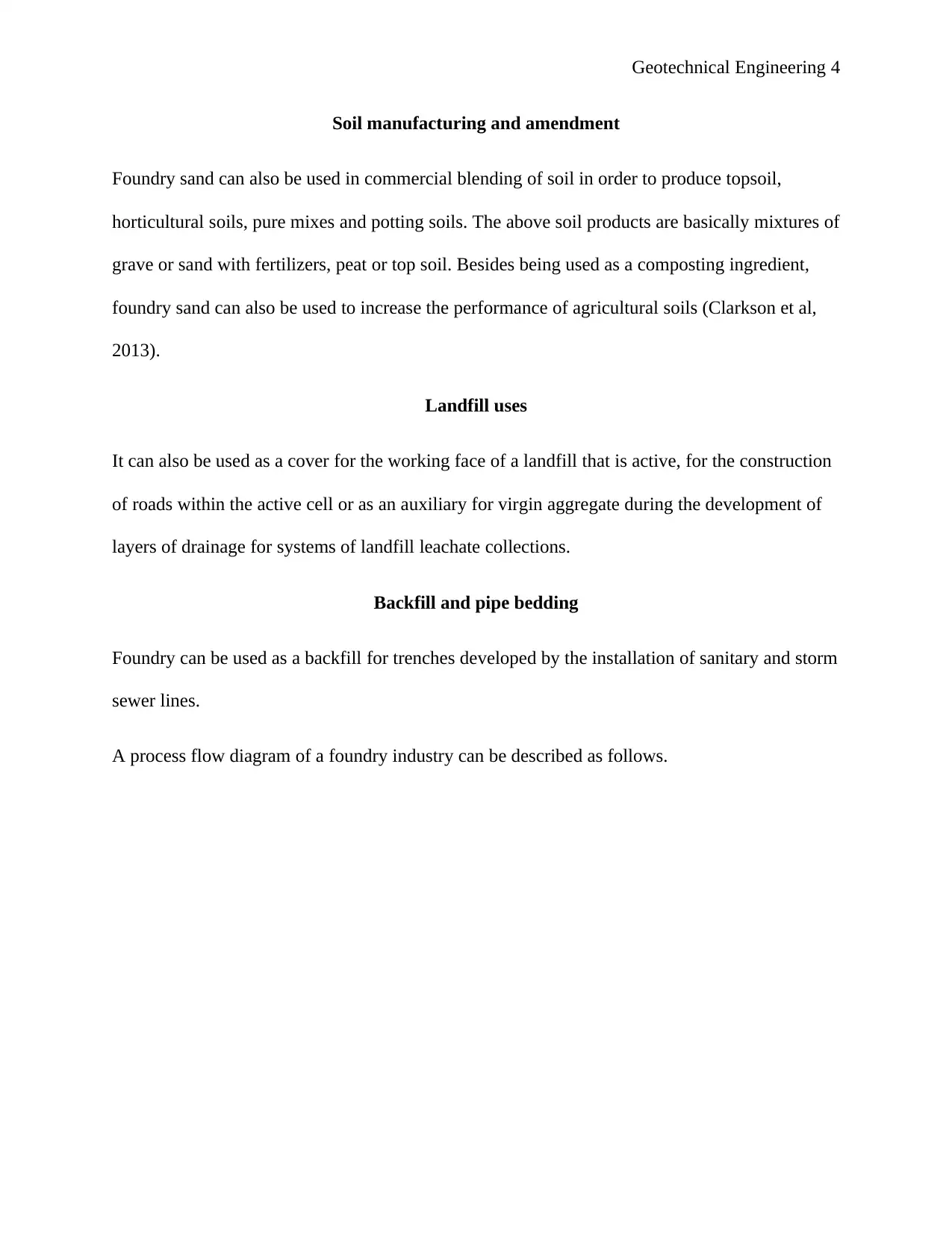
Geotechnical Engineering 4
Soil manufacturing and amendment
Foundry sand can also be used in commercial blending of soil in order to produce topsoil,
horticultural soils, pure mixes and potting soils. The above soil products are basically mixtures of
grave or sand with fertilizers, peat or top soil. Besides being used as a composting ingredient,
foundry sand can also be used to increase the performance of agricultural soils (Clarkson et al,
2013).
Landfill uses
It can also be used as a cover for the working face of a landfill that is active, for the construction
of roads within the active cell or as an auxiliary for virgin aggregate during the development of
layers of drainage for systems of landfill leachate collections.
Backfill and pipe bedding
Foundry can be used as a backfill for trenches developed by the installation of sanitary and storm
sewer lines.
A process flow diagram of a foundry industry can be described as follows.
Soil manufacturing and amendment
Foundry sand can also be used in commercial blending of soil in order to produce topsoil,
horticultural soils, pure mixes and potting soils. The above soil products are basically mixtures of
grave or sand with fertilizers, peat or top soil. Besides being used as a composting ingredient,
foundry sand can also be used to increase the performance of agricultural soils (Clarkson et al,
2013).
Landfill uses
It can also be used as a cover for the working face of a landfill that is active, for the construction
of roads within the active cell or as an auxiliary for virgin aggregate during the development of
layers of drainage for systems of landfill leachate collections.
Backfill and pipe bedding
Foundry can be used as a backfill for trenches developed by the installation of sanitary and storm
sewer lines.
A process flow diagram of a foundry industry can be described as follows.
Paraphrase This Document
Need a fresh take? Get an instant paraphrase of this document with our AI Paraphraser
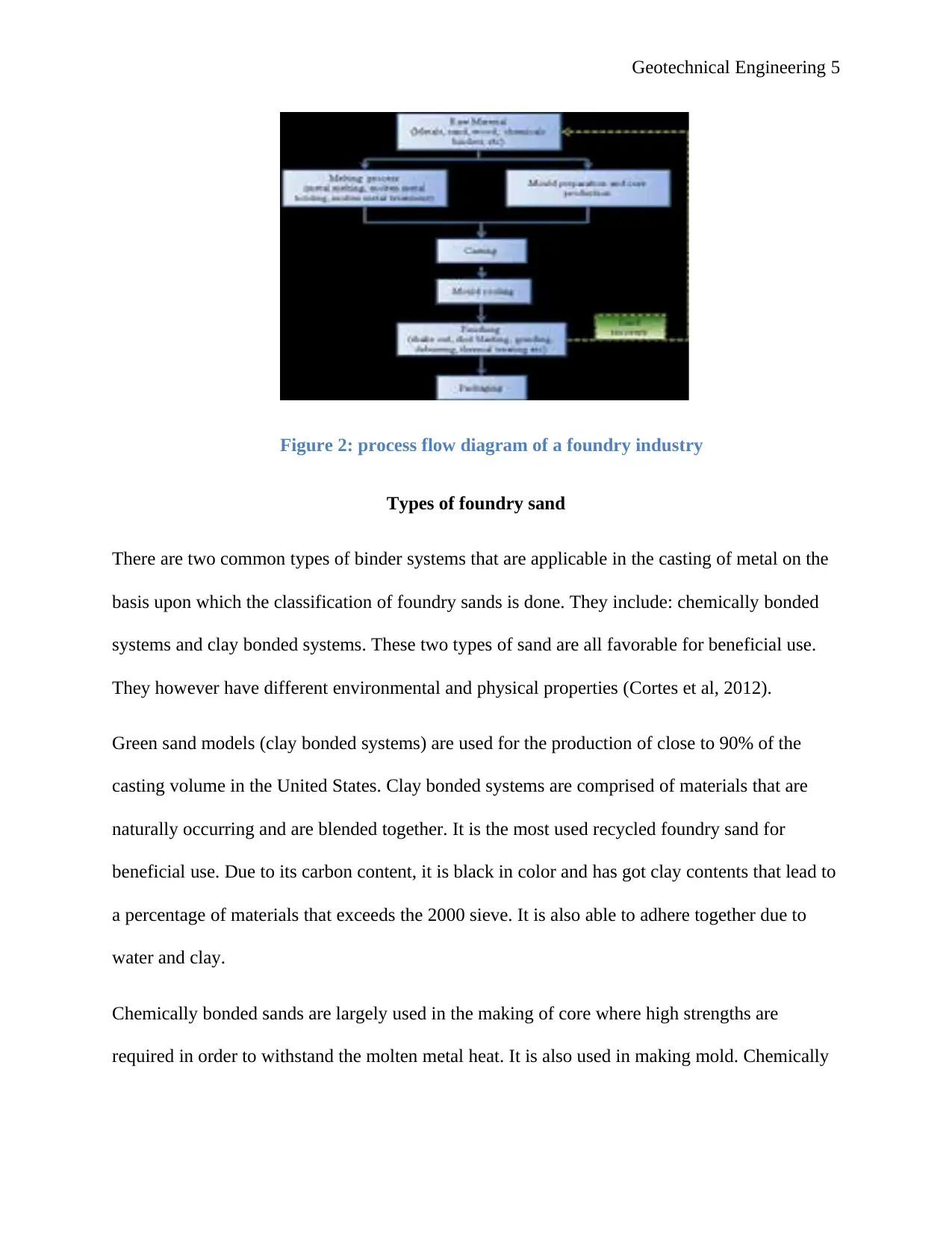
Geotechnical Engineering 5
Figure 2: process flow diagram of a foundry industry
Types of foundry sand
There are two common types of binder systems that are applicable in the casting of metal on the
basis upon which the classification of foundry sands is done. They include: chemically bonded
systems and clay bonded systems. These two types of sand are all favorable for beneficial use.
They however have different environmental and physical properties (Cortes et al, 2012).
Green sand models (clay bonded systems) are used for the production of close to 90% of the
casting volume in the United States. Clay bonded systems are comprised of materials that are
naturally occurring and are blended together. It is the most used recycled foundry sand for
beneficial use. Due to its carbon content, it is black in color and has got clay contents that lead to
a percentage of materials that exceeds the 2000 sieve. It is also able to adhere together due to
water and clay.
Chemically bonded sands are largely used in the making of core where high strengths are
required in order to withstand the molten metal heat. It is also used in making mold. Chemically
Figure 2: process flow diagram of a foundry industry
Types of foundry sand
There are two common types of binder systems that are applicable in the casting of metal on the
basis upon which the classification of foundry sands is done. They include: chemically bonded
systems and clay bonded systems. These two types of sand are all favorable for beneficial use.
They however have different environmental and physical properties (Cortes et al, 2012).
Green sand models (clay bonded systems) are used for the production of close to 90% of the
casting volume in the United States. Clay bonded systems are comprised of materials that are
naturally occurring and are blended together. It is the most used recycled foundry sand for
beneficial use. Due to its carbon content, it is black in color and has got clay contents that lead to
a percentage of materials that exceeds the 2000 sieve. It is also able to adhere together due to
water and clay.
Chemically bonded sands are largely used in the making of core where high strengths are
required in order to withstand the molten metal heat. It is also used in making mold. Chemically
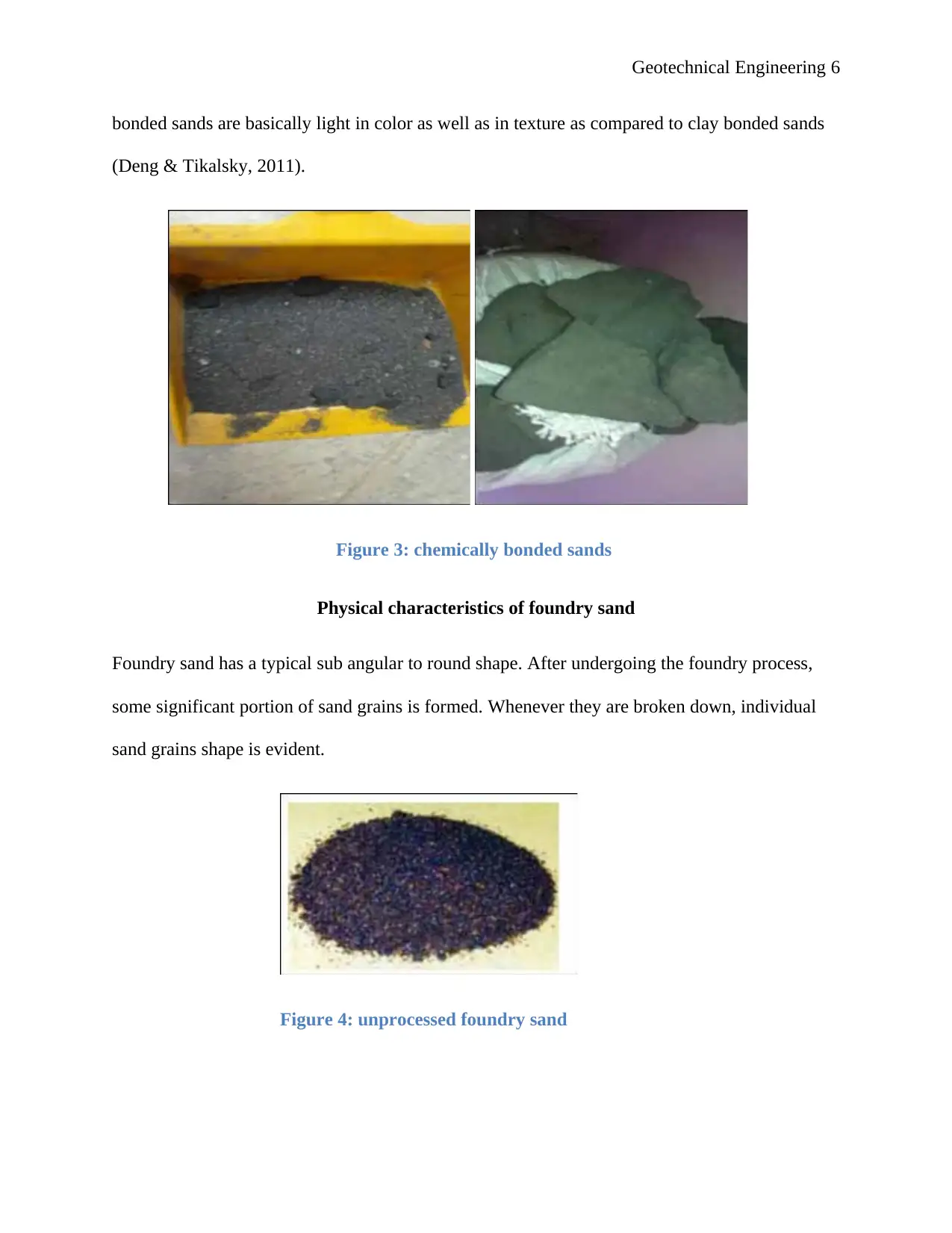
Geotechnical Engineering 6
bonded sands are basically light in color as well as in texture as compared to clay bonded sands
(Deng & Tikalsky, 2011).
Figure 3: chemically bonded sands
Physical characteristics of foundry sand
Foundry sand has a typical sub angular to round shape. After undergoing the foundry process,
some significant portion of sand grains is formed. Whenever they are broken down, individual
sand grains shape is evident.
Figure 4: unprocessed foundry sand
bonded sands are basically light in color as well as in texture as compared to clay bonded sands
(Deng & Tikalsky, 2011).
Figure 3: chemically bonded sands
Physical characteristics of foundry sand
Foundry sand has a typical sub angular to round shape. After undergoing the foundry process,
some significant portion of sand grains is formed. Whenever they are broken down, individual
sand grains shape is evident.
Figure 4: unprocessed foundry sand
⊘ This is a preview!⊘
Do you want full access?
Subscribe today to unlock all pages.

Trusted by 1+ million students worldwide
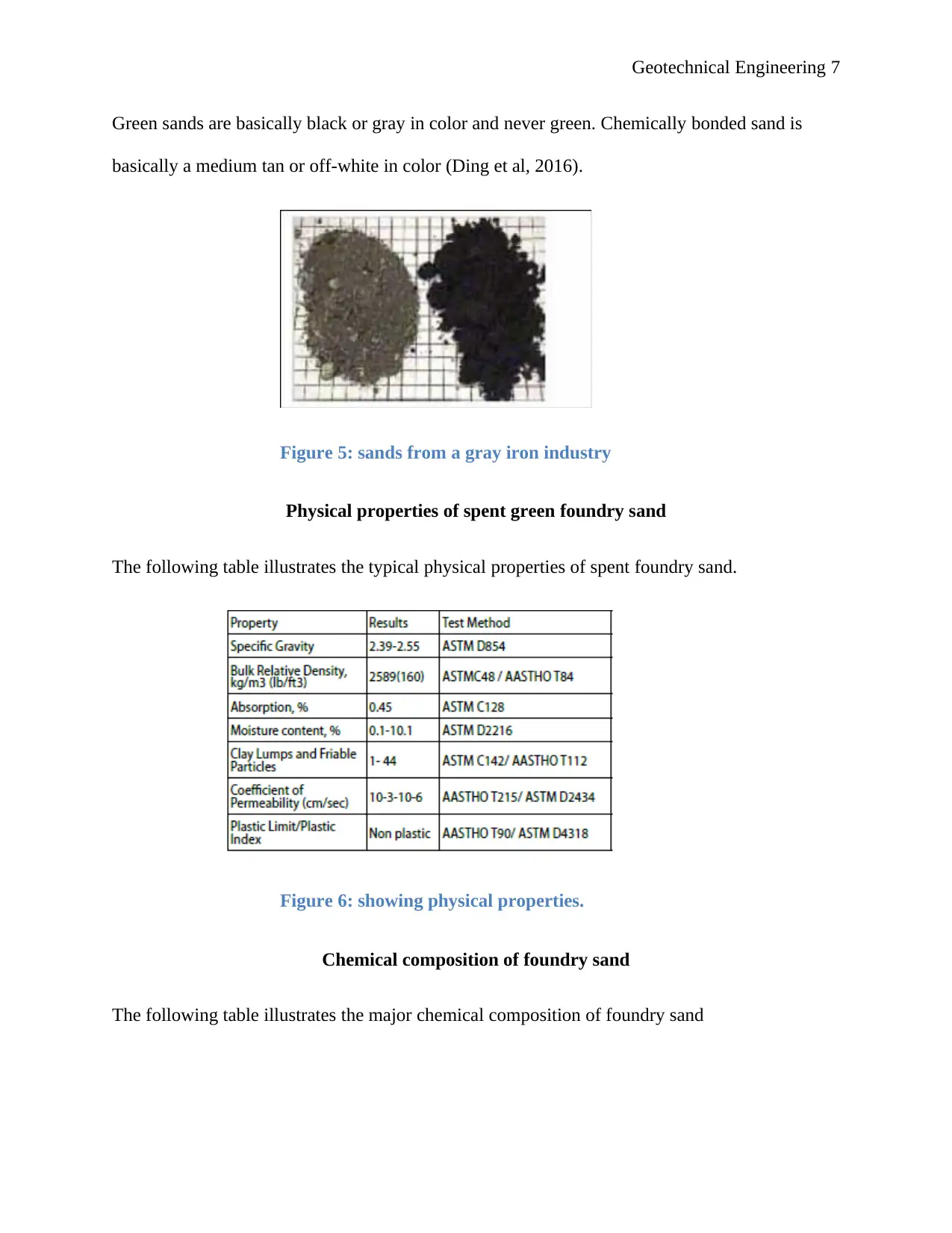
Geotechnical Engineering 7
Green sands are basically black or gray in color and never green. Chemically bonded sand is
basically a medium tan or off-white in color (Ding et al, 2016).
Figure 5: sands from a gray iron industry
Physical properties of spent green foundry sand
The following table illustrates the typical physical properties of spent foundry sand.
Figure 6: showing physical properties.
Chemical composition of foundry sand
The following table illustrates the major chemical composition of foundry sand
Green sands are basically black or gray in color and never green. Chemically bonded sand is
basically a medium tan or off-white in color (Ding et al, 2016).
Figure 5: sands from a gray iron industry
Physical properties of spent green foundry sand
The following table illustrates the typical physical properties of spent foundry sand.
Figure 6: showing physical properties.
Chemical composition of foundry sand
The following table illustrates the major chemical composition of foundry sand
Paraphrase This Document
Need a fresh take? Get an instant paraphrase of this document with our AI Paraphraser
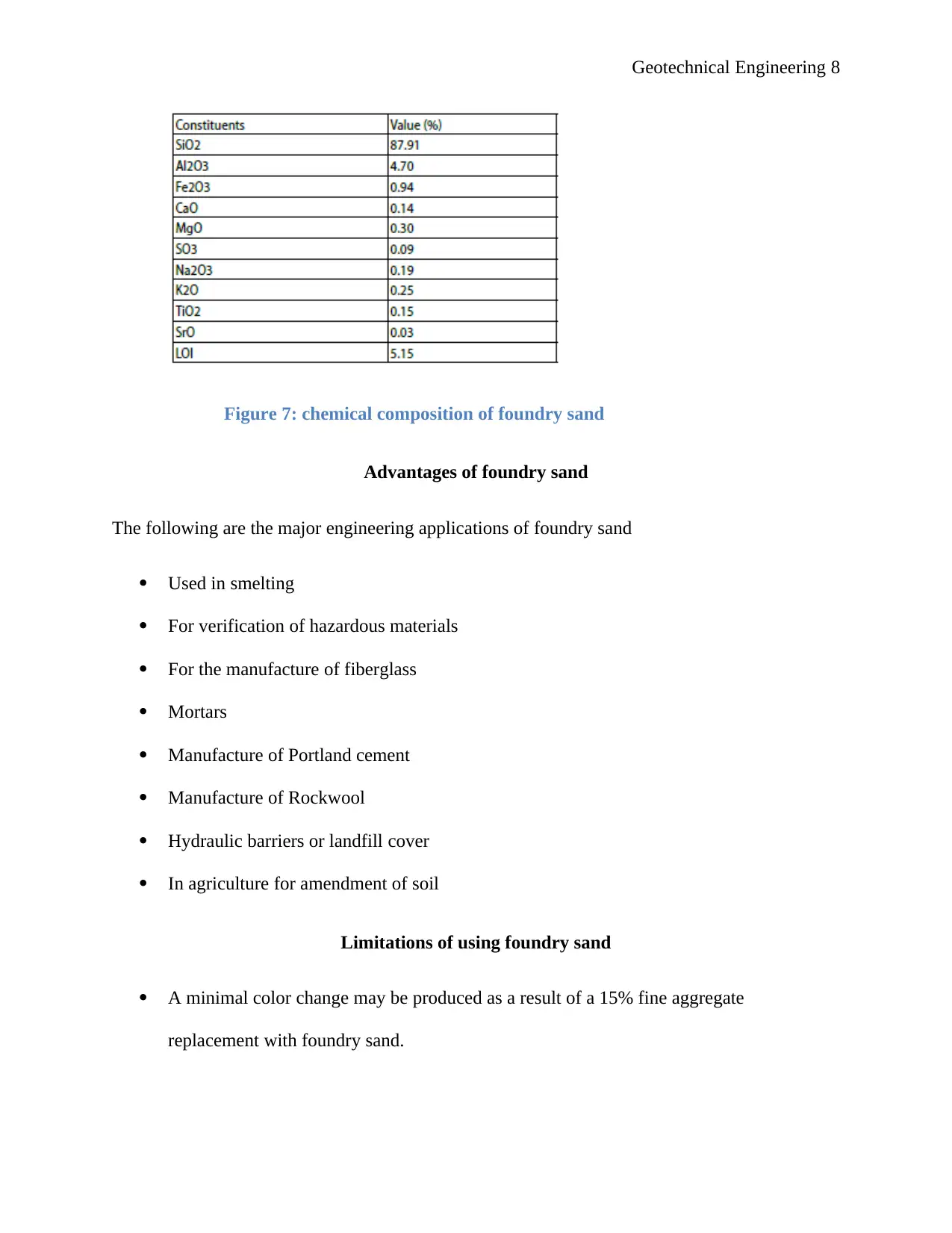
Geotechnical Engineering 8
Figure 7: chemical composition of foundry sand
Advantages of foundry sand
The following are the major engineering applications of foundry sand
Used in smelting
For verification of hazardous materials
For the manufacture of fiberglass
Mortars
Manufacture of Portland cement
Manufacture of Rockwool
Hydraulic barriers or landfill cover
In agriculture for amendment of soil
Limitations of using foundry sand
A minimal color change may be produced as a result of a 15% fine aggregate
replacement with foundry sand.
Figure 7: chemical composition of foundry sand
Advantages of foundry sand
The following are the major engineering applications of foundry sand
Used in smelting
For verification of hazardous materials
For the manufacture of fiberglass
Mortars
Manufacture of Portland cement
Manufacture of Rockwool
Hydraulic barriers or landfill cover
In agriculture for amendment of soil
Limitations of using foundry sand
A minimal color change may be produced as a result of a 15% fine aggregate
replacement with foundry sand.
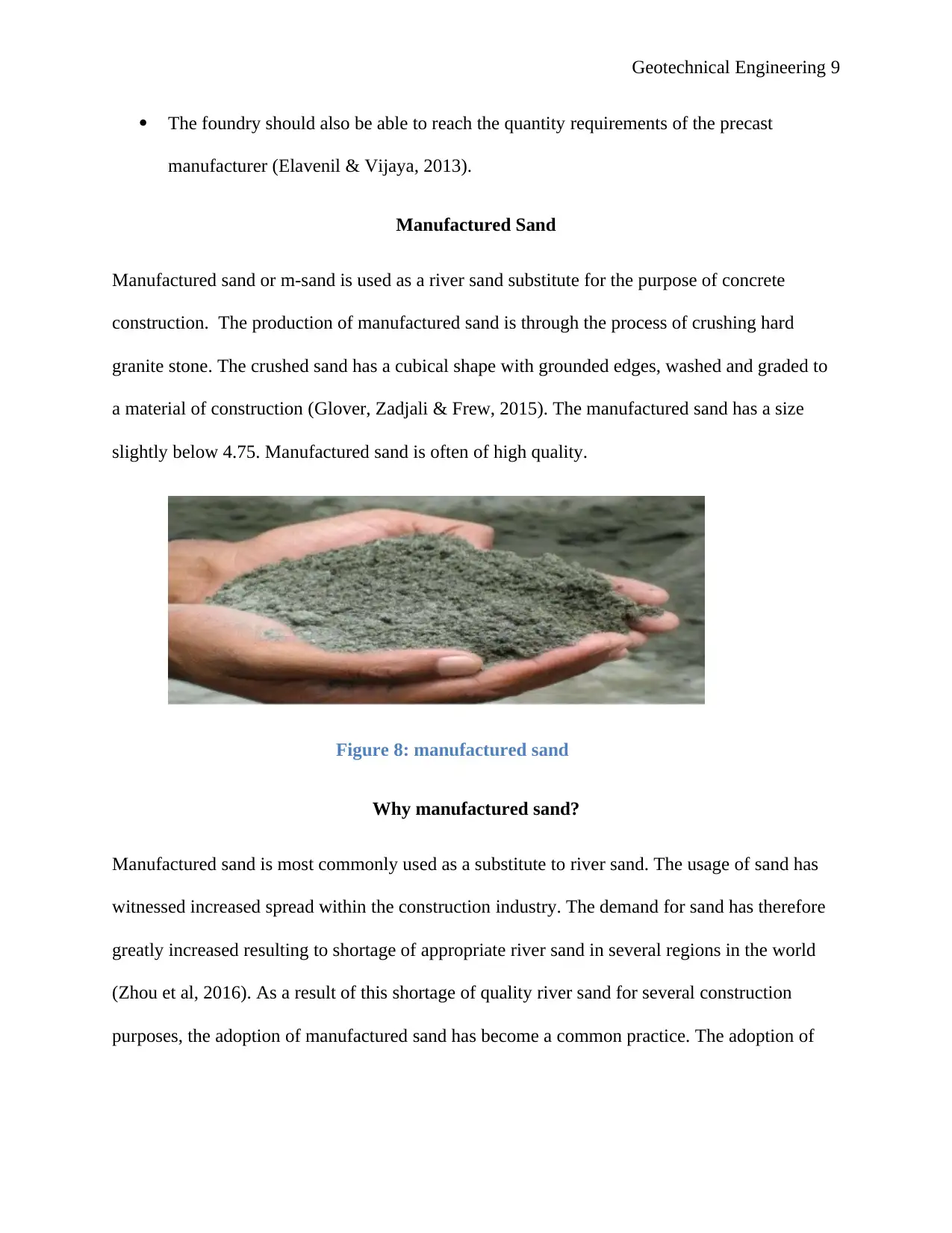
Geotechnical Engineering 9
The foundry should also be able to reach the quantity requirements of the precast
manufacturer (Elavenil & Vijaya, 2013).
Manufactured Sand
Manufactured sand or m-sand is used as a river sand substitute for the purpose of concrete
construction. The production of manufactured sand is through the process of crushing hard
granite stone. The crushed sand has a cubical shape with grounded edges, washed and graded to
a material of construction (Glover, Zadjali & Frew, 2015). The manufactured sand has a size
slightly below 4.75. Manufactured sand is often of high quality.
Figure 8: manufactured sand
Why manufactured sand?
Manufactured sand is most commonly used as a substitute to river sand. The usage of sand has
witnessed increased spread within the construction industry. The demand for sand has therefore
greatly increased resulting to shortage of appropriate river sand in several regions in the world
(Zhou et al, 2016). As a result of this shortage of quality river sand for several construction
purposes, the adoption of manufactured sand has become a common practice. The adoption of
The foundry should also be able to reach the quantity requirements of the precast
manufacturer (Elavenil & Vijaya, 2013).
Manufactured Sand
Manufactured sand or m-sand is used as a river sand substitute for the purpose of concrete
construction. The production of manufactured sand is through the process of crushing hard
granite stone. The crushed sand has a cubical shape with grounded edges, washed and graded to
a material of construction (Glover, Zadjali & Frew, 2015). The manufactured sand has a size
slightly below 4.75. Manufactured sand is often of high quality.
Figure 8: manufactured sand
Why manufactured sand?
Manufactured sand is most commonly used as a substitute to river sand. The usage of sand has
witnessed increased spread within the construction industry. The demand for sand has therefore
greatly increased resulting to shortage of appropriate river sand in several regions in the world
(Zhou et al, 2016). As a result of this shortage of quality river sand for several construction
purposes, the adoption of manufactured sand has become a common practice. The adoption of
⊘ This is a preview!⊘
Do you want full access?
Subscribe today to unlock all pages.

Trusted by 1+ million students worldwide
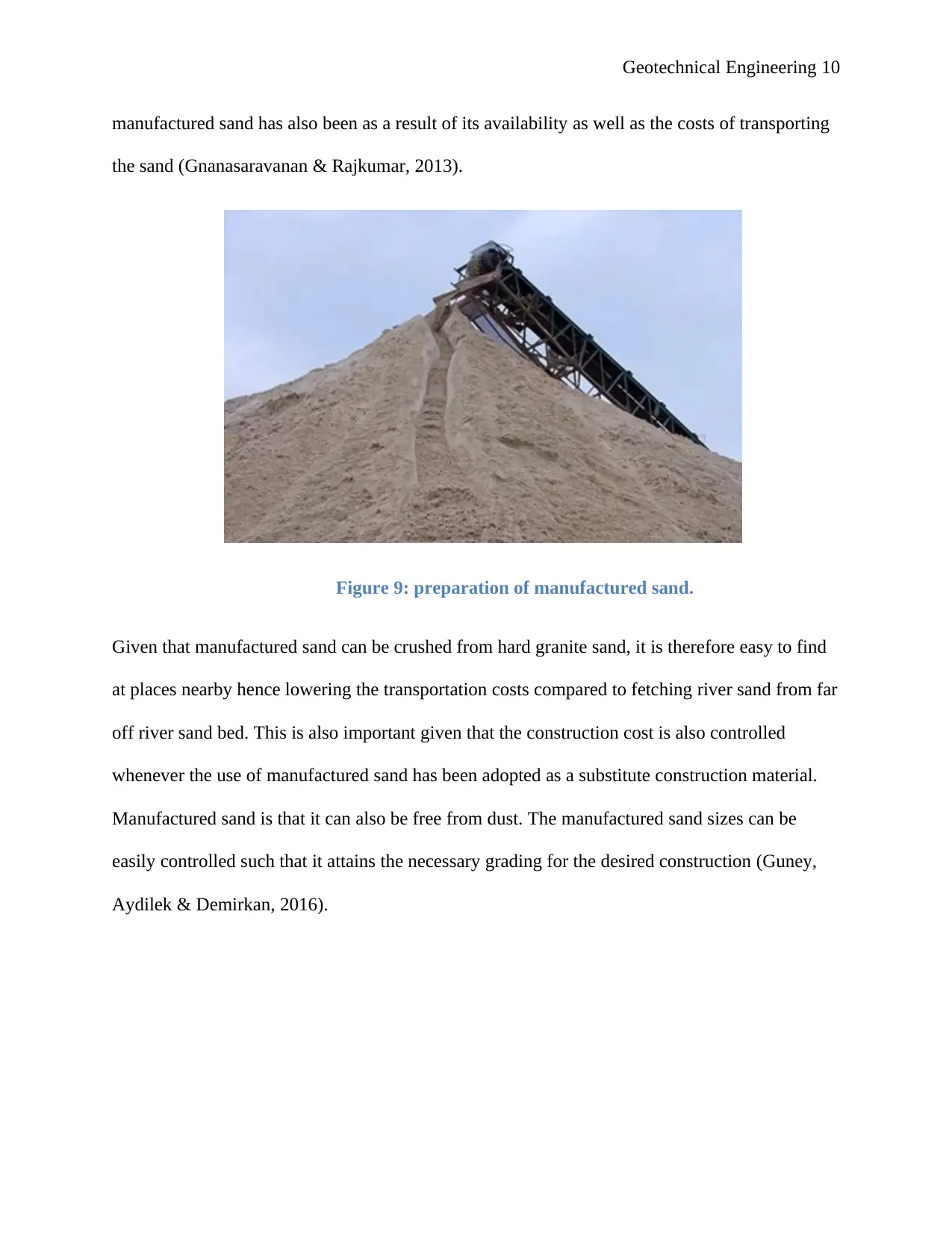
Geotechnical Engineering 10
manufactured sand has also been as a result of its availability as well as the costs of transporting
the sand (Gnanasaravanan & Rajkumar, 2013).
Figure 9: preparation of manufactured sand.
Given that manufactured sand can be crushed from hard granite sand, it is therefore easy to find
at places nearby hence lowering the transportation costs compared to fetching river sand from far
off river sand bed. This is also important given that the construction cost is also controlled
whenever the use of manufactured sand has been adopted as a substitute construction material.
Manufactured sand is that it can also be free from dust. The manufactured sand sizes can be
easily controlled such that it attains the necessary grading for the desired construction (Guney,
Aydilek & Demirkan, 2016).
manufactured sand has also been as a result of its availability as well as the costs of transporting
the sand (Gnanasaravanan & Rajkumar, 2013).
Figure 9: preparation of manufactured sand.
Given that manufactured sand can be crushed from hard granite sand, it is therefore easy to find
at places nearby hence lowering the transportation costs compared to fetching river sand from far
off river sand bed. This is also important given that the construction cost is also controlled
whenever the use of manufactured sand has been adopted as a substitute construction material.
Manufactured sand is that it can also be free from dust. The manufactured sand sizes can be
easily controlled such that it attains the necessary grading for the desired construction (Guney,
Aydilek & Demirkan, 2016).
Paraphrase This Document
Need a fresh take? Get an instant paraphrase of this document with our AI Paraphraser
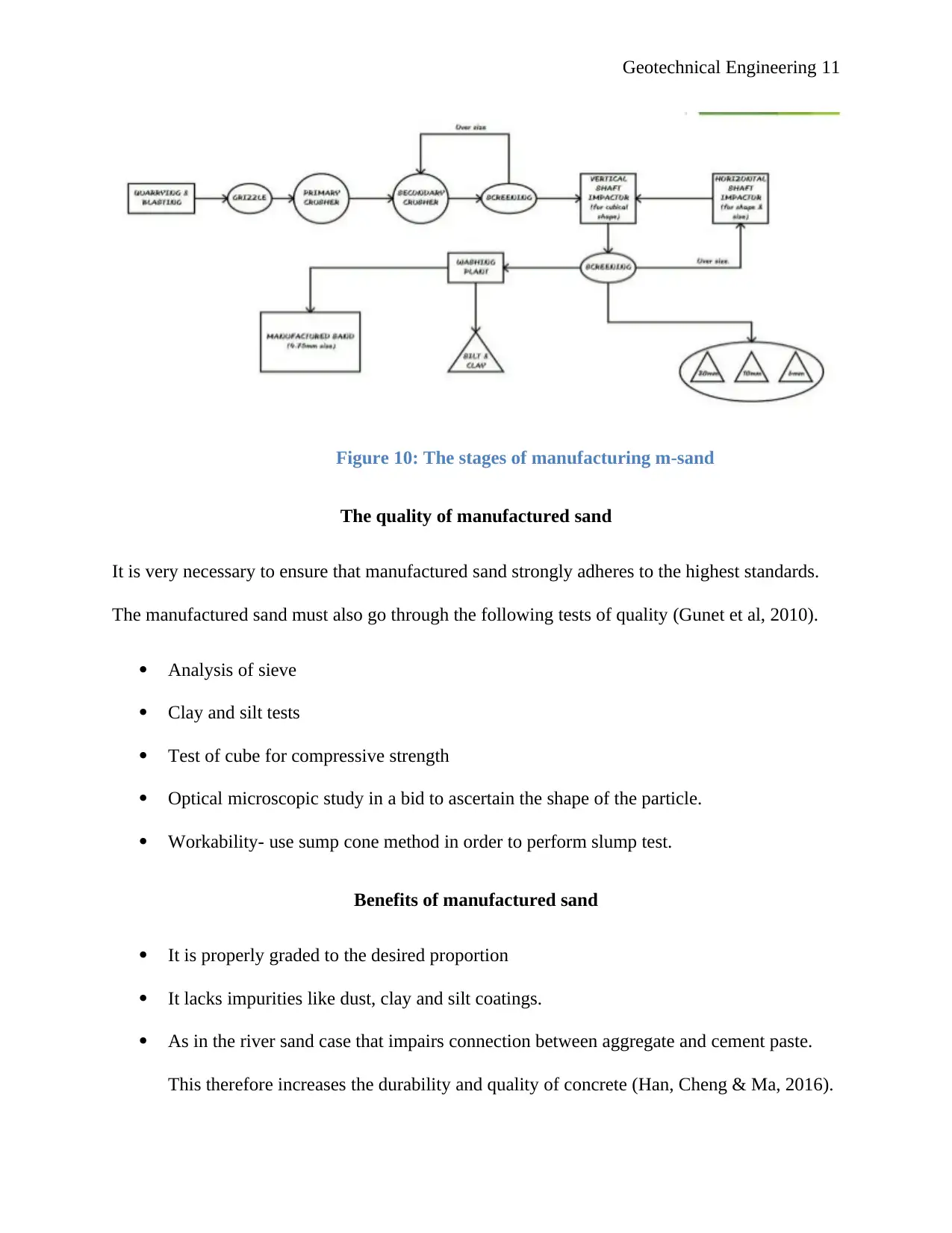
Geotechnical Engineering 11
Figure 10: The stages of manufacturing m-sand
The quality of manufactured sand
It is very necessary to ensure that manufactured sand strongly adheres to the highest standards.
The manufactured sand must also go through the following tests of quality (Gunet et al, 2010).
Analysis of sieve
Clay and silt tests
Test of cube for compressive strength
Optical microscopic study in a bid to ascertain the shape of the particle.
Workability- use sump cone method in order to perform slump test.
Benefits of manufactured sand
It is properly graded to the desired proportion
It lacks impurities like dust, clay and silt coatings.
As in the river sand case that impairs connection between aggregate and cement paste.
This therefore increases the durability and quality of concrete (Han, Cheng & Ma, 2016).
Figure 10: The stages of manufacturing m-sand
The quality of manufactured sand
It is very necessary to ensure that manufactured sand strongly adheres to the highest standards.
The manufactured sand must also go through the following tests of quality (Gunet et al, 2010).
Analysis of sieve
Clay and silt tests
Test of cube for compressive strength
Optical microscopic study in a bid to ascertain the shape of the particle.
Workability- use sump cone method in order to perform slump test.
Benefits of manufactured sand
It is properly graded to the desired proportion
It lacks impurities like dust, clay and silt coatings.
As in the river sand case that impairs connection between aggregate and cement paste.
This therefore increases the durability and quality of concrete (Han, Cheng & Ma, 2016).
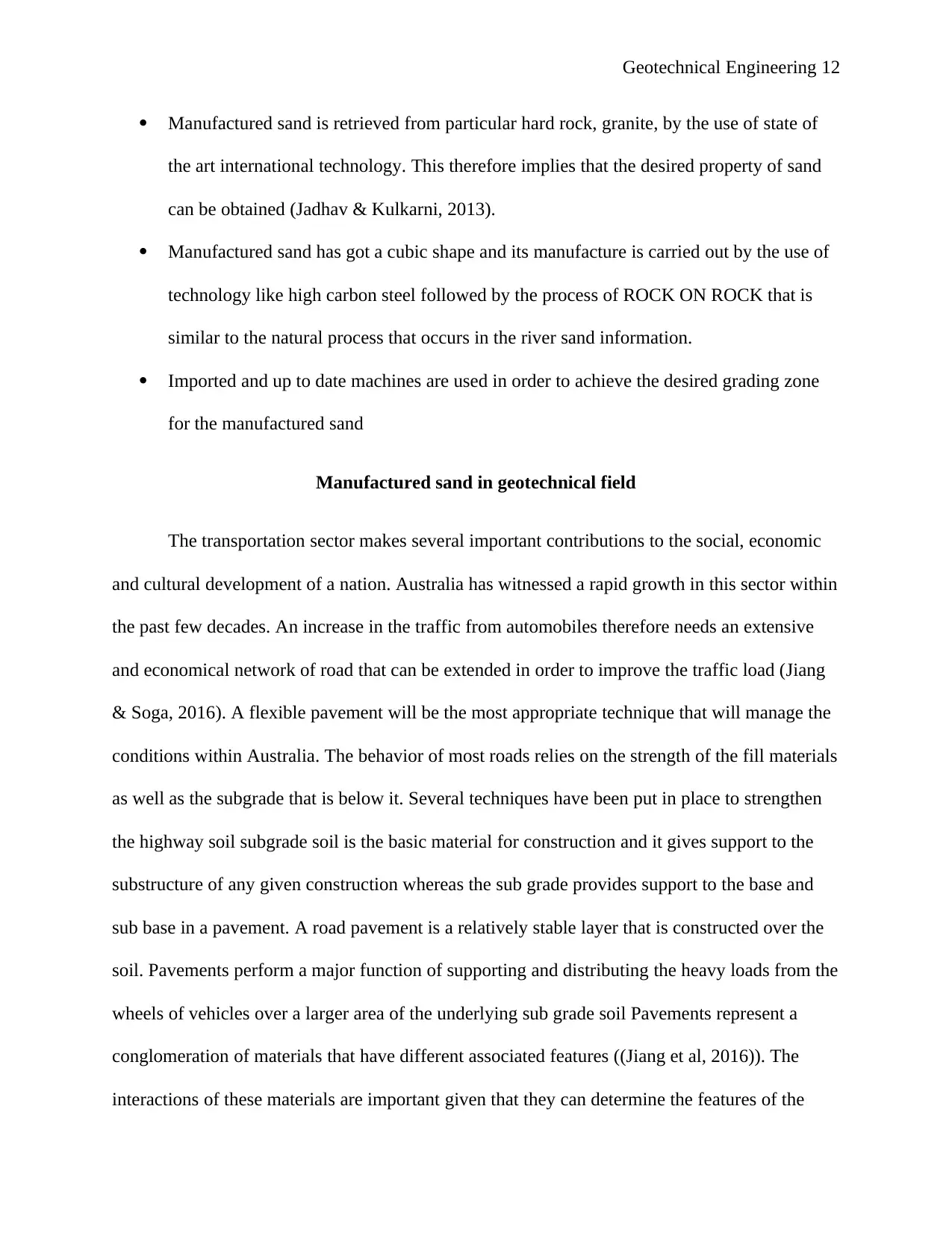
Geotechnical Engineering 12
Manufactured sand is retrieved from particular hard rock, granite, by the use of state of
the art international technology. This therefore implies that the desired property of sand
can be obtained (Jadhav & Kulkarni, 2013).
Manufactured sand has got a cubic shape and its manufacture is carried out by the use of
technology like high carbon steel followed by the process of ROCK ON ROCK that is
similar to the natural process that occurs in the river sand information.
Imported and up to date machines are used in order to achieve the desired grading zone
for the manufactured sand
Manufactured sand in geotechnical field
The transportation sector makes several important contributions to the social, economic
and cultural development of a nation. Australia has witnessed a rapid growth in this sector within
the past few decades. An increase in the traffic from automobiles therefore needs an extensive
and economical network of road that can be extended in order to improve the traffic load (Jiang
& Soga, 2016). A flexible pavement will be the most appropriate technique that will manage the
conditions within Australia. The behavior of most roads relies on the strength of the fill materials
as well as the subgrade that is below it. Several techniques have been put in place to strengthen
the highway soil subgrade soil is the basic material for construction and it gives support to the
substructure of any given construction whereas the sub grade provides support to the base and
sub base in a pavement. A road pavement is a relatively stable layer that is constructed over the
soil. Pavements perform a major function of supporting and distributing the heavy loads from the
wheels of vehicles over a larger area of the underlying sub grade soil Pavements represent a
conglomeration of materials that have different associated features ((Jiang et al, 2016)). The
interactions of these materials are important given that they can determine the features of the
Manufactured sand is retrieved from particular hard rock, granite, by the use of state of
the art international technology. This therefore implies that the desired property of sand
can be obtained (Jadhav & Kulkarni, 2013).
Manufactured sand has got a cubic shape and its manufacture is carried out by the use of
technology like high carbon steel followed by the process of ROCK ON ROCK that is
similar to the natural process that occurs in the river sand information.
Imported and up to date machines are used in order to achieve the desired grading zone
for the manufactured sand
Manufactured sand in geotechnical field
The transportation sector makes several important contributions to the social, economic
and cultural development of a nation. Australia has witnessed a rapid growth in this sector within
the past few decades. An increase in the traffic from automobiles therefore needs an extensive
and economical network of road that can be extended in order to improve the traffic load (Jiang
& Soga, 2016). A flexible pavement will be the most appropriate technique that will manage the
conditions within Australia. The behavior of most roads relies on the strength of the fill materials
as well as the subgrade that is below it. Several techniques have been put in place to strengthen
the highway soil subgrade soil is the basic material for construction and it gives support to the
substructure of any given construction whereas the sub grade provides support to the base and
sub base in a pavement. A road pavement is a relatively stable layer that is constructed over the
soil. Pavements perform a major function of supporting and distributing the heavy loads from the
wheels of vehicles over a larger area of the underlying sub grade soil Pavements represent a
conglomeration of materials that have different associated features ((Jiang et al, 2016)). The
interactions of these materials are important given that they can determine the features of the
⊘ This is a preview!⊘
Do you want full access?
Subscribe today to unlock all pages.

Trusted by 1+ million students worldwide
1 out of 36
Your All-in-One AI-Powered Toolkit for Academic Success.
+13062052269
info@desklib.com
Available 24*7 on WhatsApp / Email
![[object Object]](/_next/static/media/star-bottom.7253800d.svg)
Unlock your academic potential
Copyright © 2020–2025 A2Z Services. All Rights Reserved. Developed and managed by ZUCOL.